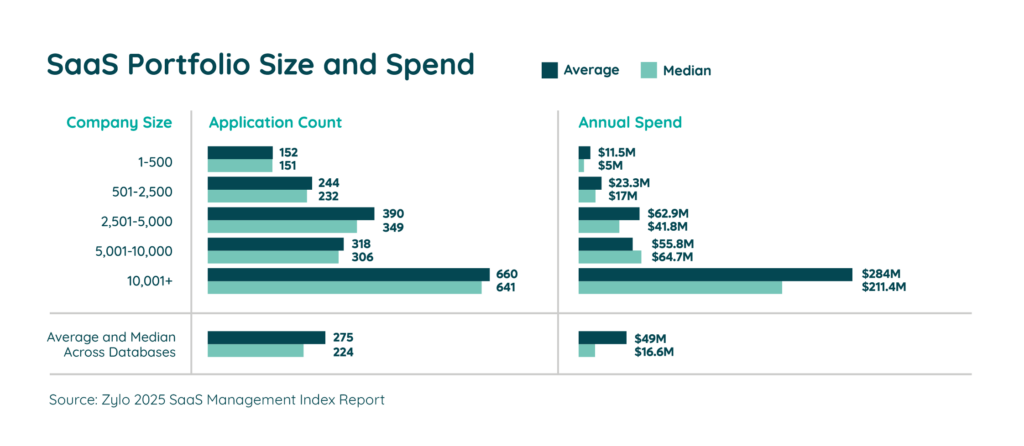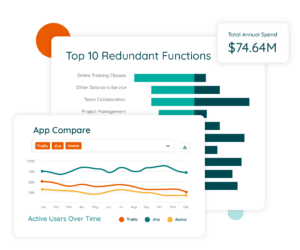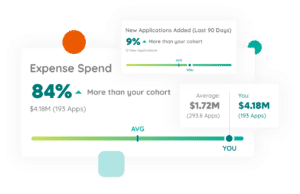Table of Contents
For many organizations, the Covid-19 pandemic brought a surge in SaaS software purchasing. Although it was undoubtedly necessary at the time to ensure that remote teams had what they needed to retain effectiveness, the landscape has shifted again. Much of what remains from these pandemic acquisitions exist only as shelfware – abandoned and unused.
In fact, Zylo has found that 53% of SaaS licenses in today’s average organization’s portfolio are unused. And that’s by no means a small amount, equating to $21M in waste each year.
The average organization’s portfolio contains 275 SaaS applications that represent $49M in annual spend. Contrast this with the average of 323 applications and $60M in spend that we saw in 2021.

However, note that we’re only seeing this decline in reference to Zylo customers who have embraced SaaS management to rationalize their portfolios. The Great SaaS Rationalization is only beginning.
Why the Great Rationalization Is Happening
But why is the Great Rationalization starting now? The simplest answer is that SaaS-aware software management is only just catching up with the radical explosion of SaaS we’ve seen over the last few years.
As we mentioned before, the downward trend in spending and portfolio size that we see today is notably among Zylo customers. These are organizations that have recognized the importance of monitoring and optimizing their SaaS portfolio. They’re looking at their portfolios, prioritizing optimization, and taking steps to make their SaaS work for them.
“We’re seeing our customers reach a level of maturity where they’re back in control, because they have a system in place, they’ve been able to get what they need to understand what’s happening from a SaaS perspective in their environment.”
– Ben Pippenger, resident SaaS expert and Zylo Co-Founder on SaaSMe Unfiltered
Optimization is especially important in today’s market environment, driving more and more organizations to recognize the opportunities in their SaaS portfolio.
Organizations today are looking to cut costs – pure and simple. Economic uncertainty demands a conservative financial posture. Gone is the growth-at-all-costs approach that’s dominated the business landscape, and organizations are prioritizing business fundamentals as a result.
Ultimately, this all means organizations across industries are looking to reduce operating costs, save money and make the most out of their investments.
To this end, software is the first place you should look. Software spend is the largest source of cost following headcount. As such, it represents a huge opportunity for cost savings outcomes.
The Practical Guide to Rationalizing, Rightsizing and Renewing SaaS
Learn MoreHow Organizations Are Rationalizing Their Portfolios
There are many ways for organizations to take advantage of this massive opportunity we see in SaaS.
Removing Duplicate and Redundant Software
An inherent problem we’ve seen in the explosion of SaaS over the last few years is the lack of visibility. Employees are expensing SaaS everywhere from the C-suite to individual employees without going through the proper channels. Needless to say, this has resulted in an abundance of applications that serve the same functions. Common culprits include applications for online training classes, team collaboration, and project management.
 Identifying these applications and removing them where necessary is one of the first stops in rationalizing a portfolio.
Identifying these applications and removing them where necessary is one of the first stops in rationalizing a portfolio.
For example, one Zylo customer, a mid-sized software company, was able to identify a lot of redundancies in their tech stack once they established full SaaS visibility. After two months of application rationalization, they were able to cancel 353 unneeded applications for $940,000 in cost savings.
Consolidating Apps with Multi-Channel Spend
This is similar to addressing your redundant software, but it has an extra sting. It is remarkably common for organizations to have an enterprise in place with a vendor. However, employees may not be aware of or have access to it. As such, they expense independent instances of the same application.
This is what we call multi-channel spend. Solving it starts by identifying these independent instances, removing them, and getting those employees behind the enterprise contract.
Sunsetting Unused Applications
SaaS renewals are often the default when adopting a new solution. This is convenient for applications you have no intention of dropping for the foreseeable future. However, they’re rather inconvenient when that application goes unused, effectively wasting money.
Organizations looking to cut waste are identifying these applications and simply not renewing. Today, we’re seeing that 30% of contracts are not being renewed as the Great Rationalization progresses.
Benchmarking
 With organizations looking to reduce operating expenses wherever they can, they want to know they’re getting the best price for their SaaS. As such, they’re looking to benchmark their applications against what their peers are paying for the same applications.
With organizations looking to reduce operating expenses wherever they can, they want to know they’re getting the best price for their SaaS. As such, they’re looking to benchmark their applications against what their peers are paying for the same applications.
This allows them to bring the power of data to the negotiating table when it’s time to renew – getting better prices on enterprise contracts and keeping their SaaS portfolio competitive.
The Great Rationalization: Now Is the Time to Get Your SaaS in Gear
Rationalizing SaaS applications is more than recognizing it as a business necessity. It takes a SaaS management program driven by the right tools to make it happen. Otherwise, your organization faces hundreds of hours chasing applications and wondering what to do when you find them.
Rather, save time, money, and energy by reading our guide to rationalizing, rightsizing, and renewing SaaS to learn how to effectively reduce the costs and risks of SaaS growth. Or, request a demo to see how Zylo can power your rationalization efforts and drive value for your organization.

